


[Imhoof-Blumer, Zur Münzkunde Boeotiens, in the Num. Zeit., iii. 1871 and ix. 1877.
B. V. Head, History of the Coinage of Boeotia, 1881.
British Museum Catalog of Greek Coins, Central Greece, by B. V. Head, 1884.]
In Boeotia, as in Phocis, the commencement of the coinage may be placed about the middle of the sixth century B.C. The most striking characteristic of the money of Boeotia is that it is in great part a Federal currency. The various Boeotian cities were from the first united in an Amphictyonic confederation, as members of which they adopted a common coin-type, which serves to distinguish the Boeotian currency from that of all other Greek states. This type is the so-called Boeotian buckler, a round or oval shield with semicircular openings at either side. It is thought that this shield is properly a religious emblem, but to what divinity it belongs we have no positive information. It may be that it is the shield of Athena Itonia, whose temple, near Coroneia, was the place where the Boeotians met to celebrate their periodical national festivals (Paus. ix. 34 ες τον κοινον συνιασιν ενταυθα οι Βοιωτοι συλλογον); or it may be that it is the shield of Ares, whose statue was the starting-
That golden shields were preserved at Coroneia we gather from another passage of Pausanias (i. 25. 7), where he relates that the Coroneians put Lachares to death (B.C. 299) because he had taken away the golden shields from the acropolis of their city, and stripped the image of Athena of her ornaments.
The earliest Boeotian coins, alike in weight, fabric, and incuse reverse, are modelled on those of Aegina, and, in these respects, are easily to be distinguished from the contemporary issues of the neighbouring island of Euboea, or of Athens. The Aeginetic standard prevailed in Boeotia down to the time of the restoration of Thebes by Cassander, B.C. 315, after which there are tetradrachms of Attic weight, and thirds of the tetradrachm, weighing about 80 grs., as in Aetolia.
Acraephia, on the eastern shore of lake Copais, is said by Pausanias (ix. 23. 5) to have belonged in early times to Thebes. It must, however, have enjoyed intervals of autonomy, both before and after the Persian wars.
| Boeotian shield. [Babelon, Traité, Pl. XLI. 16.] |
A in centre of mill-sail incuse.
AR Stater.
|
| Id. [B. M. C., Cent. Gr., Pl. VII. 1.] | A in incuse square. AR Obol.
|
| Half shield. | Id. AR ½ Obol.
|
| Boeotian shield. (On ½ obols, a half shield.) [B. M. C., Cent. Gr., Pl. VII. 3.] |
Α Κ Kantharos in incuse square.
AR Stater, Obol, and ½ Obol.
|
Chaeroneia was in B.C. 424 still subject to Orchomenus (Thuc. iv. 76. 3, cf. Hellanicus, Fr. 49), but it appears to have obtained autonomy soon afterwards at the hands of the Thebans, though there is no evidence that it struck coins before the Peace of Antalcidas.
| Boeotian shield. [Prokesch, Ined., 1854, Pl. II. 49, 50.] |
ΧΑΙ or ΧΑΙΡΩΝΕ Club.
AR ½ Dr. and Æ .7
|
Copae, on the edge of the lake Copais, not far from the katabothra into which the Cephissus flows on emerging from the lake.
| Boeotian shield. [B. M. C., Cent. Gr., Pl. VII. 4.] |
ΚΩΠΑΙΩΝ Forepart of rushing bull.
AR Obol.
|
| Id. [Prokesch, Ined., 1854, Pl. II. 51.] | Κ Ω Bull’s head, facing. Æ .45
|
The rushing bull may here symbolize the river-god Kephisos.
Coroneia, on a height at the entrance of a valley leading to Mt. Helicon.
| Boeotian shield. [Bunbury Cat., 935; Babelon, Traité, Pl. XLI. 17.] | Q in incuse square.
AR Drachm, Obol, &c.
|
| Boeotian shield. [B. M. C., Cent. Gr., Pl. VII. 6, and Num. Zeit., ix. Pl. I. 58.] | ΚΟRΟ, Κ Ο Gorgon-head, or head of
Athena Itonia, facing.
AR ½ Dr., Obol, &c.
|
| Boeotian shield. [N. C., 1898, Pl. XIX. 5.] |
ΚΟΡ in concave field. Æ .85
|
The gorgon-head on the coins of Coroneia is reminiscent of the worship of Athena Itonia, whose temple stood in the vicinity of Coroneia, and was the place where national Pan-Boeotian festivals were celebrated (Paus. ix. 34. 1). Cf. the story of Iodama, priestess of that goddess, to whom, when one night she entered the sacred temenos, the goddess appeared with the gorgoneion on her chiton, and straightway Iodama was trans- formed into stone. The custom of daily kindling fire upon the altar of Iodama was still kept up when Pausanias visited Coroneia (Paus. l. c.).
Haliartus was destroyed by the Persians in B.C. 480. There are silver coins earlier than that date, from the stater downwards, distinguished by the aspirate (⊟), the initial letter of Haliartus, placed either in the side-openings of the shield, or in the centre of the incuse on the reverse (Num. Zeit., iii. 1871, Pl. IX. 1-2).
The town was subsequently restored, and issued staters, &c., in the fifth century.
| Boeotian shield. [B. M. C., Cent. Gr., Pl. VII. 15.] |
ΑRΙ (retrogr.) or Α Amphora or kan-
tharos, in incuse square. AR Stater.
|
| Boeotian shield, on which trident. [B. M. C., Cent. Gr., Pl. VII. 16.] |
ΑRΙΑRΤΙΟΣ Poseidon Onchestios, na-
ked, striking with trident. AR Stater.
|
| Half Boeotian shield. [N. C., 1902, Pl. XV. 9.] |
Α R Trident. AR 6.4 grs.
|
These pieces refer to the celebrated temple and grove of Poseidon at Onchestus in the territory of Haliartus (Il. ii. 506), which was the meeting-place of an Amphictyonic Council of the Boeotians, ‘Ογχηστος δ’ εστιν οπου το ‘Αμφικτυονικον συνηγετο εν τη ‘Αλιαοτια * * * * εχων Ποσειδωνος ιερον (Strab. ix. 2. 33). The statue of Poseidon was still standing there in the time of Pausanias (ix. 26. 5). There is a forgery of this coin reading ΑRΙΑRΤΙΟΝ (see Imhoof, Num. Zeit., iii. 1871, 340).
| Boeotian shield. [B. M. C., Cent. Gr., Pl. VII. 17, and N. C., 1898, p. 288.] | ΑΡΙ or ΑΛΙ in plain concave field.
Æ .95
|
Lebadeia, between Mt. Helicon and Chaeroneia (Strab. ix. 414). Here was the famous oracle of Trophonius.
| Boeotian shield. [Arch. Zeit., 1848, Pl. XVIII. 6.] |
ΛΕΒΑ Fulmen. AR Diobol.
|
| Boeotian shield. [N. C., i. 1839, p. 248.] |
ΛΕΒ in plain concave field. Æ .8
|
| Head of Athena. [B. M. C., Cent. Gr., Pl. VII. 18.] |
ΛΕ in olive-wreath. Æ .6
|
Mycalessus (Hom. Il. ii. 498), situate not far from the Euripus.
| Boeotian shield. [Num. Zeit., ix. Pl. I. 60.] |
Μ in centre of mill-sail incuse.
AR Stater 189 grs.
|
| Id. [N. C., 1890, Pl. XIX. 8.] | Id. AR Drachm 95 grs.
|
| Half Boeotian shield. [Num. Zeit., ix. p. 22.] |
Μ in incuse square.
AR ½ Obol(?) 4.5 grs.
|
| Boeotian shield. [B. M. C., Cent. Gr., Pl. VIII. 1.] |
Μ Υ Fulmen. AR Obol.
|
| Id. | Μ Grapes or Kantharos. AR ½ Obol, &c.
|
Orchomenus or Erchomenus. In very early times the Minyan Orcho- menus had been a member of the naval confederation of Calauria on the Saronic Gulf, and the first city of Boeotia (E. Curtius, Hermes, x. p. 385). This fact points to the existence of commercial relations between Orchomenus and Aegina, and perhaps accounts for the intro- duction into Boeotia of a system of coinage modelled upon that of Aegina. The early silver coins of Orchomenus differ from those of the other Boeotian towns in that they are without the buckler characteristic of the Boeotian Federal money. This type was not adopted at Orcho- menus until the fourth century B.C.
| Ε or ΕR One or three sprouting grains of corn, or, on the ½ obols, a half corn-grain. | Incuse square, of the Aeginetan pattern
[B. M. C., Cent. Gr., Pl. VIII. 2 sqq.]
AR Obol, ¾ Obol, and ½ Obol.
|
| Boeotian shield. [B. M. C., Cent. Gr., Pl. VIII. 8, 9.] |
ΕΡΧΟ Galloping horse or amphora;
symbol, ear of corn. Magistrate's
name ΕΥΔΟΡΟ, &c. AR Stater.
|
| Id. [Ibid., Pl. VIII. 9.] | ΕΡΧ in corn-wreath. AR ½ Drachm.
|
| Ε Ρ Three corn-grains; one corn- grain; or half corn-grain. [Ibid., Pl. VIII. 13, and Num. Zeit., 1871, Pl. IX. 5-9.] | Horse; wheel; corn-wreath; or ear of
corn. AR ¾ Obol, ½ Obol, &c.
|
| Boeotian shield. [Ibid., Pl. VIII. 16.] |
Ε Ρ Χ Ο between rays of a star.
Æ .65
|
Eudoros’s name also appears on the contemporary Federal money of Boeotia issued at Thebes.
| Boeotian shield. [Ibid., Pl. VIII. 17.] |
ΟΡΧ in plain concave field. Æ .85
|
| Bust of Hera, veiled. [Ibid., Pl. VIII. 18.] |
ΕΡΧΟ Tripod. Æ .5
|
Pharae, about four miles north-west of Tanagra, appears, from the number of its coins which are still extant, to have ranked among the most prosperous members of the Boeotian Confederacy during the flourishing period before the Persian invasion.
| Boeotian shield. [Ibid., Pl. IX. 1; Babelon, Traité, No. 1350.] | AR Stater, Drachm, &c.
|
From the invasion of Xerxes until the Peace of Antalcidas the mint at Pharae appears to have been dormant.
| Boeotian shield. [Ibid., Pl. IX. 2.] | Φ Α Amphora. AR Obol.
|
Plataea. The only known silver coins of Plataea belong to the period between the Peace of Antalcidas, B.C. 387, when the city was restored by the Spartans, and its second destruction by Thebes in B.C. 372.
| Boeotian shield. [B. M. C., Cent. Gr., Pl. IX. 3, 4.] |
ΠΛΑ Head of Hera in profile or facing,
wearing stephanos.
AR ½ Dr., Diobol, &c.
|
The head of Hera on these coins may be that of the statue by Praxiteles in the Heraeum there (Paus. ix. 2. 7).
| Boeotian shield. [Ibid., Pl. IX. 5.] | ΠΛΑ in plain concave field. Æ .85
|
Tanagra and federal Coinage. This city, which stood on the left bank of the Asopus not far from the borders of Attica, was in importance second only to Thebes among all the members of the Boeotian League.
| Boeotian shield with Τ Τ or Τ Α in
the side openings. [B. M. C., Cent. Gr., Pl. XI. 6-8.] |
Incuse square of mill-sail type, in the
divisions of which sometimes Τ Τ.
AR Dr., ½ Dr., Obol, &c.
|
| Forepart of bridled horse. | Τ in one division of mill-sail incuse.
AR ¼ Dr. (?)
|
| Id. [Ibid., Pl. IX. 9-17.] | Τ Α, Β Ο Ι, or Β Ο between the spokes
of a wheel, or AR Stater, ½ Dr., Obol, &c.
|
From the inscr. ΒΟΙ on these coins we might infer that after the humiliation of Thebes (circ. B.C. 479), Tanagra aspired for a time to the leadership of the Boeotian Confederacy. This inference is, however, considered as doubtful by Grenfell and Hunt (Oxyrhynchus Papyri, v. p. 228).
| Boeotian shield. [Babelon, Traité, Pl. XLI. 28; B. M. C., Cent. Gr., Pl. X. 1-4.] | ΤΑΝΑ, ΤΑΝ, or ΤΑ Incuse square, or,
later, concave circle, in which fore-
part of springing horse.
AR Stater and ½ Drachm.
|
| Id. | Τ Α Horse’s head in incuse square.
AR Obol.
|
| Id. [Ibid., Pl. X. 8.] | Τ Α Stern of galley. AR Obol.
|
Of the horse, as a Tanagraean coin-type, various interpretations have been suggested. It may, as in Thessaly, be an emblem of Poseidon Onchestios, the god of the Boeotian Amphictyony, or it may have a more restricted and local signification, and symbolize the river Asopus which is seen from Tanagra forcing its way through a rocky ravine from the Parasopia into the Tanagraean plain, or again it may be the horse of the sun-god Apollo, whose temple at Delium stood in the territory of Tanagra. In this case it would express the same idea as the wheel, unless, indeed, we adopt the theory that both horse and wheel are simply agonistic types referring to horse and chariot races.
| Boeotian shield. [Ibid., Pl. X. 10.] | ΤΑΝ in plain concave field. Æ .85
|
From Augustus to Commodus coins were struck at Tanagra, both with and without the emperors’ heads (Num. Zeit., ix. pp. 30 sqq., and B. M. C., Cent. Gr., Pl. X. 11-16). Inscr. ΤΑΝΑΓΡΑΙWΝ. Types ΑCΩΠΟC Head of the River. ΠΟΙΜΑΝΔΡΟC Bust of Poemandros the mythical founder. The three Charites (?) draped; Hermes Kriophoros and Hermes Proma- chos, probably from the statues of that god (Paus. ix. 22); copy of statue, under distyle portico, of Dionysos, by Kalamis, with vanquished Triton beneath his feet. (Paus. ix. 20. 4; the myth is discussed by H. Bulle,
Thebes and Federal Coinage. The earliest coins of Thebes, circ. B.C. 600-550, are anepigraphic.
| Boeotian shield. [B. M. C., Cent. Gr., Pl. V. 1-5; Babelon, Traité, Pl. XLI. 1-4; and N. C., 1896, Pl. II. 8.] | Incuse square, divided into eight tri-
angular parts.
AR Stater, Drachm, &c.
|
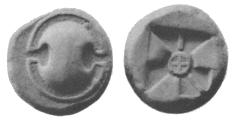
| Boeotian shield (or ½ shield on the 1/2 Obols). (Fig. 193.) [B. M. C., Cent. Gr., Pl. XI. 1-8.] | Θ or ΘΕΒΑ in incuse square of
‘mill-sail’ pattern, or in plain incuse
square on Obols, &c. AR Stater, &c.
|
| Similar. [B. M. C., Cent. Gr., Pl. XI. 9-17; N. C., 1900, 11; and R. N., 1895, Pl. IV. 12, 13.] | Amphora (or, on some of the ½ and 1/4
obols, Club) in incuse square with
or without Θ or ΘΕ.
AR Stater, Drachm, ½ Dr., Obol, &c.
|
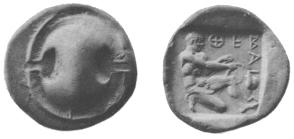
After the battle of Coroneia (B.C. 447), when the Boeotian League, upon the expulsion of the Athenians, was reconstituted under her hegemony, Thebes began to consolidate her authority throughout Boeotia and monopolized the right of coining money. To this period belongs the series of Theban staters bearing various types, mainly representations of Herakles, walking with club and bow (Brit. Mus. Guide, Pl. XIII. 16); kneeling or stooping, stringing his bow (Fig. 194, cf. Z. f. N., xxi. Pl. IV. 6); carrying off the Delphic tripod (Brit. Mus. Guide, Pl. XIII. 18); or as an infant strangling serpents (B. M. C., Cent. Gr., Pl. XII. 7). To this last mentioned type a special significance seems to have been attached, for at a later date (circ. B.C. 394) we find it adopted as symbolical of the struggle for emancipation of young and vigorous democracies against the daemons of darkness, of freedom as against tyranny (cf. coins of an
| Boeotian shield. [Brit. Mus. Guide, Pl. XIII. 15.] |
ΘΕΒΑ Incuse square, within which,
seated female figure holding helmet.
AR Stater.
|
The figure on the reverse has been thought to represent Harmonia, daughter of Ares and Aphrodite, and wife of the Theban Cadmus. But it may be merely a personification of the eponymous nymph of the city of Thebes.
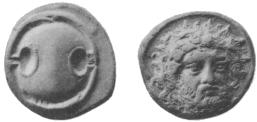 |
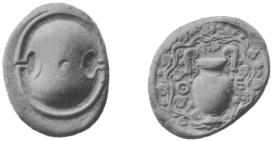 |
| FIG. 195. | FIG. 196. |
The crossed form of the letter Θ (Θ) is no longer used in this period. It should also be noted that on some of the hemidrachms the ethnic is written ΘΕΒΗ[ΟΝ] instead of ΘΕΒΑΙΟΝ, the letter Η having been used in the Boeotian dialect to represent the diphthong ΑΙ, shortly before the introduction of the other letters of the Ionian alphabet. The principal reverse types on the silver coins are heads of bearded Herakles in profile (B. M. C., Cent. Gr., Pl. XIII. 1, 2), or facing (R. N., 1895, Pl. IV. 11), or of bearded Dionysos crowned with ivy (Fig. 195); Amphora encircled by an ivy-wreath richly decorating the entire field of the coin (Fig. 196); Kantharos; or Infant Herakles strangling serpents (Fig. 197). For the smaller denominations see Head, Coinage of Boeotia, p. 41. The Trite- morion has three half-shields on both sides, the Hemiobol one half-shield, rev. Amphora, and the Tetartemorion a whole shield, rev. Kantharos.
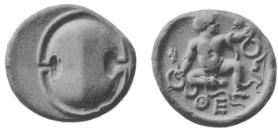
Here also belong the rare pale gold coins of Thebes.
| Head of bearded Dionysos. [B. M. C., Cent. Gr., Pl. XIV. 1, 2.] |
Θ Ε Infant Herakles strangling ser-
pents. AV 46.3 grs. and 15.8 grs.
|
At the Peace of Antalcidas Thebes lost her ascendancy over the other Boeotian cities, which now all began again to coin in their own names. In 382 the Cadmeia was seized by the Spartans, and Thebes did not recover her freedom until 379. It is doubtful whether any coins were struck at Thebes in this period.
After the recovery of the Cadmeia by Pelopidas and his associates, and under the able leadership of Epaminondas, Thebes obtained an influence throughout Hellas, second to that of no other Greek state. A new Federal Boeotian currency was put into circulation about this time (B.C. 378) which from the number of known varieties must have lasted down to the Macedonian conquest in B.C. 338. Historically this coinage is extremely interesting. It appears to have been issued by the authority of the central βουλη of the reconstituted Boeotian league, which, doubtless, like the older league, consisted of eleven Boeotarchs with their βουλευται representing the βουλαι of the separate Boeotian communities. The meeting-place of this Federal βουλαε was the Cadmeia of Thebes. It is improbable that the magistrates’ names on the coins of this series are those of the successive eponymous Boeotarchs of the league. They are rather those of members of a sub-committee, επιμελεια, specially appointed to superintend the finances of the mint. The members of this committee, probably in rotation, may have been officially respon- sible for the coins struck during their term of office. This federal coinage superseded the issues of the separate members of the Boeotian league. The types of the stater are as follows :—
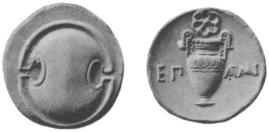
| Boeotian shield (Fig. 198). | Amphora and magistrate’s name in
abbreviated form. AR Stater.
|
Silver staters of this type are known with the names of the following magistrates:—ΑΓΛΑ, ΑΜΦΙ, ΑΝΔΡ, ΑΝΤΙ, ΑΠΟΛ, ΑΡΚΑ, FΑΣΤ, ΑΣΩΠ, ΒΟΙΩ, ΔΑΙΜ, ΔΑΜΟΚΛ, ΔΑΜΩ, ΔΙΟΓ, ΔΙΟΚ, ΔΙΩ, ΕΠΑΜΙ, ΕΠΠΑ, FΕΡΓ, ΕΥFΑΡΑ, ΕΥΓΙ, Ε↓Ε, ΕΧΕ, ΘΕΟΓ, ΘΕΟΠ, ΗΙΚΕ, ΗΙΣΜΕ, ΚΑΒΙ, ΚΑΛΙ, ΚΑΛΛΙ, ΚΛΕΕΣ, ΚΛΕΣ, ΚΛΙΩΝ, ΚΡΑΤ, ΛΥΚΙ, ΞΕΝΟ, ΟΛΥΜ, ΟΝΑΣ, ΠΕΛΙ, ΠΘΟ or ΠΟΘ, ΠΟΛΥ, ΠΤΟΙ, ΤΙΜΙ, ΤΙΜΟ, ΦΙΔΟ or ΦΙΛΟ, ΨΑRΟ, ΧΑΡ.
Several of these names may, as might be expected, be identified with those of persons mentioned by historians or in inscriptions, such as Ismenias and Androkleidas, the well-known leaders of the Atticizing party at Thebes, together with their followers Amphithemis or Amphi-
Small silver and bronze coins also occur with some of the same magistrates’ names :—
| Boeotian shield. [B. M. C., Cent. Gr., Pl. XV. 10.] |
Head of young Herakles with names
ΕΠ, ΘΕ, ΙΣ, ΚΛΕ, ΚΟ, &c. AR Obol.
|
| Head of young Herakles. [Ibid., Pl. XV. 11-17.] |
Club, often with arrow, bow, thyrsos,
grapes or caduceus, and magistrates’
names, which are frequently identical
with those on the silver coins. (For
list of these names see Head, Coinage
of Boeotia, p. 70). Æ .5
|
After the disastrous battle of Chaeroneia a Macedonian garrison was placed in the Cadmeia, and three years afterwards Thebes was destroyed by Alexander. The Federal mint must have been at this time transferred to some other Boeotian city, perhaps Orchomenus. The coins now bear no magistrates’ names :—
| Boeotian shield. [B. M. C., Cent. Gr., Pl. V. 14.] |
ΒΟ ΙΩ Amphora, and changing symbol.
AR Stater.
|
| Id. [Ibid., Pl. V. 16.] | ΒΟ Ι Kantharos; symbol, crescent.
AR ½ Dr.
|
| Id. [Ibid., Pl. V. 17.] | ΒΟΙΩΤΩΝ Trident; symbol, dolphin.
Æ .6
|
Thebes was rebuilt by Cassander after having lain in ruins for twenty years. Both he and his successor Demetrius appear to have struck money at Thebes with the types and name of Alexander the Great, distinguished by the presence of the Boeotian shield as an adjunct symbol on the reverse (Müller, Nos. 751-756). There are also small bronze coins, which seem to belong to this time.
| Head of young Herakles. | ΘΗΒΑΙΩΝ Thyrsos and club. Æ .4
|
| Boeotian shield. [B. M. C., Cent. Gr., Pl. XVI. 1, 2.] |
„ Trident. Æ .4
|
In B.C. 288, Demetrius, who had now fallen from the height of his power, presented Thebes with her freedom, hoping perhaps thereby to
attach Boeotia to his cause. From this time until B.C. 244 Boeotia was independent of Macedon. The coins which on grounds of style may be assigned to this half-century bear the inscription ΒΟΙΩΤΩΝ, but were without doubt struck at Thebes.

| Head of Poseidon (?) crowned with wreath (Fig. 199). | ΒΟΙΩΤΩΝ Poseidon holding dolphin
and trident, seated on throne, on the
side of which is a Boeotian shield.
AR Attic tetradr.
|
| Head of Athena in Corinthian helmet. [B. M. C., Cent. Gr., Pl. VI. 2.] |
ΒΟΙΩΤΩΝ Trophy. Æ .85
|
| Head of young Herakles. [Ibid., Pl. VI. 3, 4.] |
„ Winged Athena wielding
fulmen. Æ .75
|
| Head of young Dionysos. [Ibid., Pl. VI. 5.] |
„ Apollo seated on basis
surmounted by tripod. Æ .7
|
In B.C. 244 Boeotia was once more compelled to place herself under the protection of Macedon as a defence against the marauding Aetolians. During the reigns of Antigonus Gonatas, Demetrius II, and Antigonus Doson, B.C. 244-221, it is probable that only Macedonian coins were current in Boeotia, but with the accession of Philip V a larger measure of autonomy was accorded to the Boeotians. The Boeotian bronze coins struck after this date are as a rule restruck on money of Antigonus Doson. The silver coins, which closely resemble the bronze, are drachms (?) weighing about 80 grs. of the standard in use in Aetolia.
| Head of Persephone facing. [Brit. Mus. Guide, Pl. XLII. 19.] |
ΒΟΙΩΤΩΝ Poseidon standing resting
on trident, and holding dolphin.
AR 80 grs.
|
| Id. [B. M. C., Cent. Gr., Pl. VI. 8.] | ΒΟΙΩΤΩΝ Poseidon standing, resting
one foot on rock. Æ .8
|
In this period Boeotia, like the rest of Greece, was permitted by the Romans to retain its autonomy, but financial disorganization prevailed throughout the land to such an extent that the state actually issued bronze money in the place of silver, identical with the silver both in size and types, and perhaps nominally equivalent to it (B. V. Head, Coinage of Boeotia, p. 91).
| Head of Poseidon laureate. [Brit. Mus. Guide, Pl. LV. 22.] |
ΒΟΙΩΤΩΝ Nike standing holding
trident and wreath, various mono-
grams. AR 80 grs., Æ .7
|
It is probable that in this period small bronze coins were struck at Thebes and some other Boeotian towns.
| Boeotian shield. [B. V. Head, Coinage of Boeotia, p. 94.] |
ΘΗΒΑΙΩΝ Nike standing, resting on
trident. Æ .5
|
Under the Emperors Galba, and perhaps Trajan, Thebes issued bronze coins bearing magistrates’ names preceded by ΕΠΙ and their titles, Archiereus, or Polemarch (Head, Coinage of Boeotia, p. 95).
Thespiae. Of this town there are no archaic coins. Its earliest issues fall into the period between B.C. 387 and 376-4, when, after the Peace of Antalcidas, Thespiae had become one of the strongholds of the Spartans in Boeotia. The Thespian coins are epigraphically very instructive, as they indicate the precise epoch of the introduction of Σ in place of the older S into Boeotia. Mythologically also the coins of Thespiae are of value, as they prove that in addition to Eros, who was the god especially revered at that city, Aphrodite Melainis (Paus. ix. 27) was there wor- shipped as a Moon-goddess. The crescent, the constant mint-mark of Thespian money, is the symbol of this goddess.
| Boeotian shield. [B. M. C., Cent. Gr., Pl. V. 11.] |
Amphora; symbol, crescent. AR ½ Dr.
|
| Id. [Ibid., Pl. XVI. 5, 6.] | ΘΕSΠΙ Two crescents. AR Obol
|
| Id. (or ½ shield on ½ obol). [Ibid., Pl. XVI. 7; Head, Coinage of Boeotia, p. 55.] | ΘΕS or ΘΕΣ Crescent.
AR Obol, ½ Obol, ¼ Obol.
|
| Boeotian shield. [Ibid., Pl. XVI. 8.] |
ΘΕΣΠΙΚΟΝ or ΘΕΣ Head of Aphro-
dite Melainis; in front and beneath,
a crescent. AR Stater and ½ Drachm.
|
| Id. Crescent on shield. [Ibid., Pl. XVI. 10.] |
Θ Head of Aphrodite. AR Obol.
|
| Half shield, on which, crescent (B. M.). | ΘΕΣ retrogr. Head of Aphrodite.
AR ½ Obol.
|
From B.C. 374-338 Thespiae was subject to Thebes and struck no coins, but after the battle of Chaeroneia it obtained the right of coining in bronze.
| Boeotian shield. [Ibid., Pl. XVI. 11.] | ΘΕΣ in plain concave field. AR .85
|
From the date of the restoration of Thebes (B.C. 315) there is another interval in the coinage of Thespiae, and it does not begin again until after B.C. 146, when the Romans appear to have restored to many Greek cities the right of coining bronze (cf. Paus. vii. 16. 7).
| Female head, wearing stephanos and veil. | ΘΕΣΠΙΕΩΝ Lyre in wreath [B. M. C.,
Cent. Gr., Pl. XVI. 12, 13]. Æ .6-.45
|
| Head of Athena. [Sest., Mus. Font., ii. Pl. IV. 17.] | ΘΕΣΠΙΕΩΝ Artemis huntress. Æ .5
|
Imperial coins are known of the Emperor Domitian only. The usual type is Apollo Kitharoedos, standing, or seated, or a female figure, Tyche (?), standing. (B. M. C., Cent. Gr., Pl. XVI. 14-16.)